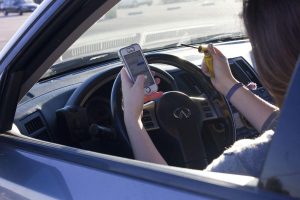In our fast-paced society, it’s hard to remember to be safe and focus solely on the road when rushing to sports practice or work. When trying to balance busy schedules, the driver’s seat sometimes becomes a place for eating, changing or texting.

Twenty-five percent of teens answer a text message at least once each time they drive and 20 percent of teens have long conversations over text message while driving, according to the U.S. Government Website for Distracted Driving.
“Driving is just a regular part of life, so it’s sort of just become when you want to find something out, when you want to talk to somebody, you just do it right then because you can and because it’s at your fingertips. People aren’t patient,” Redwood psychologist Julia VanderVennet said.
It’s difficult to do two things at once and do them well, according to Byron Nelson, a Redwood P.E. teacher and ABC Driving School instructor.
“You can’t multitask mentally––your brain can only do one task at a time––so if you’re on your phone you aren’t paying attention to driving. There’s no middle ground,” Nelson said.
When someone attempts to multitask while driving, they are not only endangering themselves, but others around them as well.
Junior Lilia Cargill got rear-ended when she was stopped in the back parking lot at lunch in the beginning of the school year.
“I’d stopped behind someone else and there was a good couple seconds and then my friend and I lurched forward. We looked behind us and the other person had crashed into us,” Cargill said.
According to Cargill, the person driving behind her was distracted at the time of the crash.
“They had two other people in the car. They just weren’t paying attention because they obviously didn’t see me stop,” she said.
Cargill said that the crash has made her a more cautious driver, and she now tries to keep her distractions to a minimum.
“I think there are a lot of different factors that distract you, like having friends in the car or just changing the radio station,” Cargill said. “You just have to know how much distraction you can handle.”
It only takes five seconds to send a text, but when driving at a speed of 55 miles per hour, one can cover the entire length of a football field, according to the U.S. Government Website for Distracted Driving.
“You have to break the habit and it’s twice as hard to break a habit than it is to form one,” VanderVennet said. “If your phone rings while you’re driving, you’re going to have that urge and be distracted just thinking about, ‘Oh, I should answer it, I should answer it.’”
According to VanderVennet, there is a lot of pressure on students to have a multitude of extracurricular activities, and because of this, many students will drive while doing something else to get ready for the next place they’re rushing to.
The best way to stay safe from distracted drivers is to be careful and follow the rules of the road, according to Nelson.
“If you’re following a car and are two seconds behind them, it doesn’t matter what they do. You can still stop in time,” Nelson said.
Nelson recommends giving people extra space if they’re swerving because this may be a sign that they are distracted.
When teaching, Nelson tries to stress the importance of being careful.
Hands-free mode on smartphones is the best way to keep from being distracted, according to Nelson.
“You can send a text and you don’t have to ever touch your phone so it’s totally hands free,” he said.
However, this would only apply for older drivers, because all cell phone use, even if it is hands free, is prohibited for drivers under 18.






